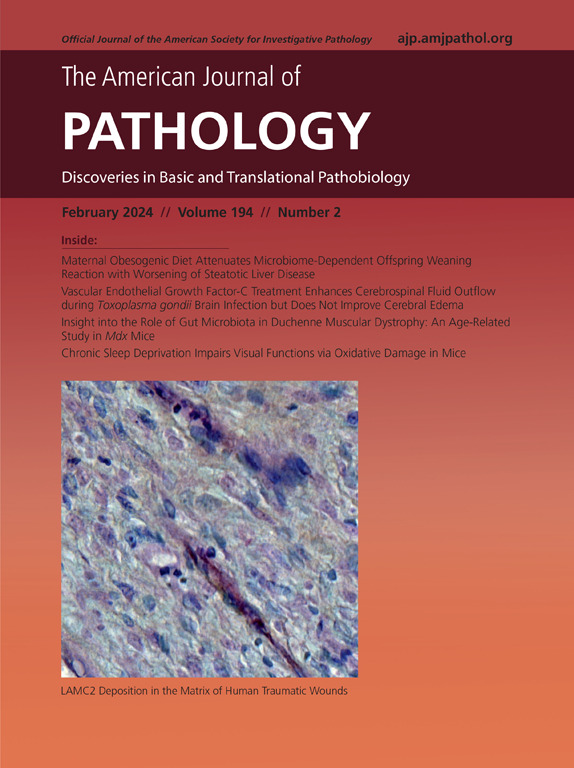肝Asah1基因消融破坏肝脂质稳态并促进小鼠纤维化性非酒精性脂肪性肝炎
IF 4.7
2区 医学
Q1 PATHOLOGY
引用次数: 0
摘要
非酒精性脂肪性肝病(NAFLD)包括一系列慢性肝病,从单纯脂肪变性到非酒精性脂肪性肝炎,后者可能发展为纤维化/肝硬化。本文对GSE163211数据集进行了分析,发现Asah1(编码酸性神经酰胺酶)是与肥胖患者NAFLD分期呈正相关的关键溶酶体基因。为了评估Asah1在NAFLD进展中的作用,将Asah1fl/fl/Albcre小鼠(肝细胞特异性缺失Asah1)和Asah1 floxed (Asah1fl/fl/野生型)小鼠分别饲喂正常饮食或高脂肪、高胆固醇饲料(PD) 20周。结果显示,肝细胞特异性Asah1消融可显著加重pd诱导的肝脂肪变性、肝炎和细胞凋亡,并导致明显的纤维化改变。此外,Asah1基因消融加重了pd诱导的门静脉血流动力学异常。在培养的肝细胞中,Asah1基因敲低导致神经酰胺和胆固醇水平升高,但不影响甘油三酯水平。敲除Asah1基因也对脂质稳态途径产生广泛影响,包括脂肪生成、脂肪酸摄取、脂肪酸氧化和脂质转运。此外,Asah1基因敲低导致内质网应激和脂滴生物生成增加。最后,Asah1基因敲低会损害伴侣蛋白介导的自噬。综上所述,这些结果提示Asah1是肝脏脂质稳态的重要调节因子,其缺乏加重肝细胞脂毒性和损伤,促进纤维化性非酒精性脂肪性肝炎的发生。本文章由计算机程序翻译,如有差异,请以英文原文为准。
Ablation of Hepatic Asah1 Gene Disrupts Hepatic Lipid Homeostasis and Promotes Fibrotic Nonalcoholic Steatohepatitis in Mice
Nonalcoholic fatty liver disease (NAFLD) encompasses a spectrum of chronic liver conditions, ranging from simple steatosis to nonalcoholic steatohepatitis, which may progress to fibrosis/cirrhosis. Here, the GSE163211 data set was analyzed, and Asah1 (encoding acid ceramidase) was identified as a crucial lysosomal gene that positively correlated with NAFLD stages in obese patients. To evaluate the role of Asah1 in the progression of NAFLD, Asah1fl/fl/Albcre mice (hepatocyte-specific deletion of Asah1) and Asah1 floxed (Asah1fl/fl/wild-type) mice were fed with either a normal diet or a high-fat, high-cholesterol paigen diet (PD) for 20 weeks. Hepatocyte-specific Asah1 ablation markedly aggravated PD-induced hepatic steatosis, hepatitis, and apoptosis, and resulted in marked fibrotic changes. In addition, Asah1 gene ablation exacerbated PD-induced portal venous hemodynamic abnormality. In cultured hepatocytes, Asah1 gene knockdown resulted in increased ceramide and cholesterol levels but did not affect triglyceride level. Knocking down Asah1 gene also exhibited broad impacts on lipid homeostasis pathways, including lipogenesis, fatty acid uptake, fatty acid oxidation, and lipid transport. Furthermore, Asah1 knockdown resulted in increased endoplasmic reticulum stress and lipid droplet biogenesis. Finally, Asah1 gene knockdown impaired chaperone-mediated autophagy. These results suggest that Asah1 functions as an important regulator of hepatic lipid homeostasis, and its deficiency exacerbates hepatocyte lipotoxicity and injury, and promotes the development of fibrotic nonalcoholic steatohepatitis.
求助全文
通过发布文献求助,成功后即可免费获取论文全文。
去求助
来源期刊
CiteScore
11.40
自引率
0.00%
发文量
178
审稿时长
30 days
期刊介绍:
The American Journal of Pathology, official journal of the American Society for Investigative Pathology, published by Elsevier, Inc., seeks high-quality original research reports, reviews, and commentaries related to the molecular and cellular basis of disease. The editors will consider basic, translational, and clinical investigations that directly address mechanisms of pathogenesis or provide a foundation for future mechanistic inquiries. Examples of such foundational investigations include data mining, identification of biomarkers, molecular pathology, and discovery research. Foundational studies that incorporate deep learning and artificial intelligence are also welcome. High priority is given to studies of human disease and relevant experimental models using molecular, cellular, and organismal approaches.

 求助内容:
求助内容: 应助结果提醒方式:
应助结果提醒方式:


